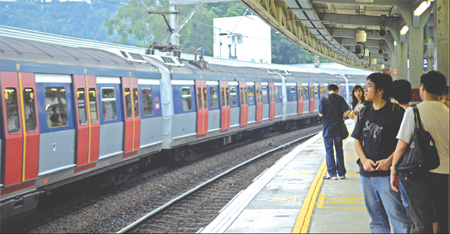Light rail for a better integrated Hong Kong
Updated: 2010-07-13 07:40
By Ho Lok-Sang(HK Edition)
|
|||||||||
|
Passengers await a train at an MTR station. Nelson Ching / Bloomberg News |
Physically, the distance between Tsing Yee and Tsuen Wan West, and that between Tsuen Wan West and Tsuen Wan, is only about one kilometer. A light rail to connect these three MTR stops would extend no more than three kilometers. I am not an engineer, but I know that to build a bridge across Rambler Channel to link the Tung Chung/Airport Express Line with Tsuen Wan West would be challenging. Nevertheless, I see a huge synergy effect if this can be done.
For a long time, the Airport Express has suffered the disadvantage of limited access. The airport express has only three stops in town: Tsing Yee, Kowloon, and Hong Kong. The Island Line can connect with the Airport Express, but the Tsuen Wan Line connects with the Airport Express only at the Central Station. It is unlikely to draw users from the Tsuen Wan Line or the Kwun Tong Line. The West Rail is now gaining in importance, as a trunk-line linking the northwest New Territories to the urban area. It does not however connect with the Airport Express at all. The West Rail does connect with the Tung Chung Line at Nam Cheung. But without an easy link with Tsing Yee, access to the Tung Chung Line is limited and access to the Airport Express is non-existent.
It is important to recognize that Tsuen Wan, Yuen Long and Tuen Mun all are highly populous areas. In 2006 Tsuen Wan including Kwai Tsing, Yuen Long and Tuen Mun had populations respectively of over 812,000, 534,000, and 502,000. A light rail connecting Tsing Yee with Tsuen Wan West would allow close to two million people living along the West Rail to use the Airport Express. It would tremendously enhance the attractiveness of all these towns, as well as that of Tsing Yi. It is entirely possible that the increase in land rent incidental to the enhanced railway connection would pay for the cost of construction. The MTR followed the model of recouping much of its railway construction cost from land development with remarkable success. In addition the SAR government sells land and collects land premiums and land rents from homeowners and businesses and land developers. This has allowed Hong Kong to enjoy very low direct tax rates and virtually no sales tax. Such a model is possible and efficient as long as its services bring net value to its residents and businesses. The proposed light rail links constitute a major improvement in Hong Kong's infrastructure and deserve serious consideration.
Instead of linking Tsuen Wan West with Tsuen Wan MTR station, the proposed light rail from Tsing Yi may connect with Tai Wo Hau and then continue to link with Tai Wai on the East Rail. This latter link is much longer, and will be more costly to construct, requiring tunneling among other things. However, once such a link is in place, the East Rail and West Rail will join in North Kowloon rather than only in South Kowloon, where the West Rail turns north shortly after the Austin station to reach Tsim Sha Tsui East and end in Hung Hom, the station from which East Rail starts.
Tai Wai and Tsuen Wan are located approximately in the geographic center of the whole of the Hong Kong SAR. I see significant benefits from linking East Rail and West Rail in the middle of the whole territory of Hong Kong rather than in Tsim Sha Tsui, since the 1.1 million people in East Territories (not counting Sai Kung) and the 2 million people in West territories (inclusive of Tsuen Wan) can truly take advantage of both lines. Readers may remember that the extension from Nam Cheong to Tsim Sha Tsui East to Hung Hom led to sharp housing price and land price increases in the northwest New Territories within weeks of the opening. The huge land price increases hint at the great benefits from the extension. The government was able to collect much more revenue from land sales, land use conversion premiums, and rates. The extension was so important because of the significant improvement in access afforded such a huge population.
Our proposed extensions fall exactly into this category: benefiting huge populations and improving access significantly. Such improvements will help make our local economy more vibrant, improve business and job opportunities, reduce our welfare payments, and generally make our communities better integrated. If extending the Island Line to the south of Hong Kong Island is considered worthwhile, the proposed links should be even more worthwhile, because the benefits are not limited to a small section of the community but will be enjoyed by the entire society as a whole.
The author is director of the Centre for Public Policy Studies, Lingnan University.
(HK Edition 07/13/2010 page2)
